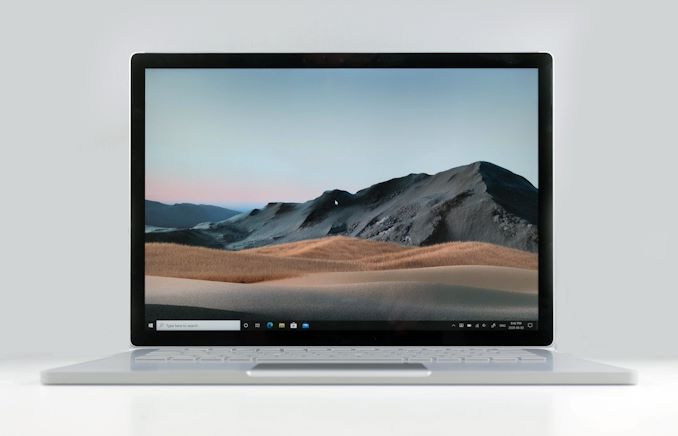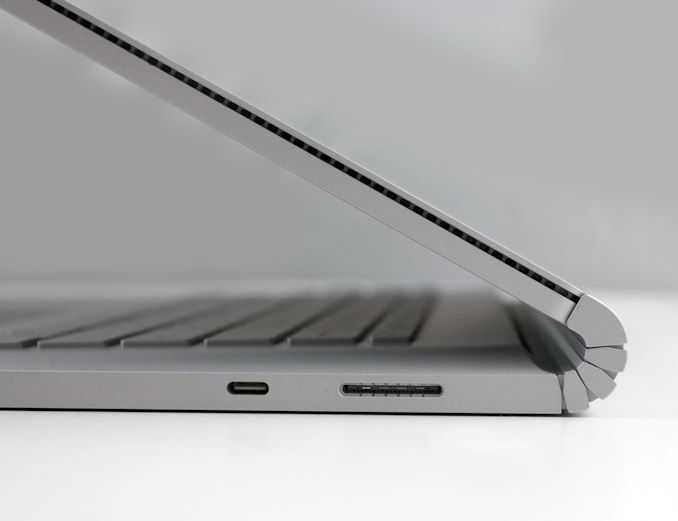The Microsoft Surface Book 3 (15-Inch) Review: A Refreshing Dip Into Ice Lake
by Brett Howse on June 3, 2020 9:00 AM EST
The PC industry has introduced some remarkably exciting designs over the last five years or so. Some of those designs, such as the thin-bezel laptop, have been adopted by almost all players in the industry. Microsoft has certainly been an innovator in the space as well, and the Surface Pro series has become the baseline for an entire category that did not exist in any volume before their launch.
But almost certainly, one of the quirkiest designs to come out of the Surface group has been the Surface Book. First launched in 2015, the Surface Book took an unusual approach to convertible laptops, incorporating an electromechanically detachable screen, and putting processors in both halves of the laptop. The original Surface Book was succeeded by the Surface Book 2 in 2017, and recently Microsoft launched the third generation of their most powerful notebook computer.
With Surface Book 2, Microsoft first introduced the 15-inch version of the notebook, and for 2020, the company is continuing to offer both 13.5-inch and 15-inch models. The electromechanically detachable tablet portion is certainly the highlight feature, and one which the entire design hinges on, pun intended. Microsoft’s Dynamic Fulcrum hinge, which expands the footprint of the base as the laptop is opened, is what provides the Surface Book with its very unique look and feel. Fittingly, for Surface Book 3, Microsoft has opted to keep chassis virtually identical to its predecessor.
Instead the Surface Book 3 is all about the internal upgrades, and they are all significant. The new Book gets an infusion of Intel's Sunny Cove CPU architecture in the form of their newest Ice Lake platform. Built on the company's 10 nm process, it is the first major architectural change since 2015's Skylake, and brings with it more performance, better power management, and a much-improved iGPU. Microsoft has also included the latest NVIDIA GPUs targeting laptops in 2020, with the smaller 13.5-inch Surface Book 3 offering an optional GeForce GTX 1650 Max-Q, while the larger 15-inch model sports the GeForce GTX 1660 Ti Max-Q, both of which are nice steps up in performance over the previous generation's GTX 1050, and GTX 1060 offerings. Also in a first for Surface, the new Book 3 is also optionally available with a NVIDIA Quadro RTX 3000, one of the company's professional-focused GPUs.
The move to Ice Lake also means that for the first time, the Surface Book 3 is now available with up to 32 GB of LPDDR4X RAM, double the maximum capacity versus the previous generation. The 16 GB limit was a function of previous Intel laptop CPUs only supporting LPDDR3, and for a laptop that competes against powerful opponents, this is an important addition.
| Microsoft Surface Book 3 | |||||
| 13.5 No GPU | 13.5 GPU | 15 As configured: 32GB / 512GB / $2799.99 |
|||
| CPU | Intel Core i5-1035G7 Quad-Core w/Hyperthreading 1.2-3.7 GHz 6MB Cache 15W TDP |
Intel Core i7-1065G7 Quad-Core w/Hyperthreading 1.3-3.9 GHz 8MB Cache 15W TDP |
|||
| RAM | Up to 32GB LPDDR4X | ||||
| GPU | Intel Iris Plus G7 | Intel Iris Plus G7 + NVIDIA GTX 1650 Max-Q 4GB | Intel Iris Plus G7 + NVIDIA GTX 1660Ti Max-Q 6GB | ||
| Storage | 256 GB to 2 TB | ||||
| Display | 13.5" PixelSense 3000x2000 3:2 sRGB Touch and Pen enabled |
15" PixelSense 3240x2160 3:2 sRGB Touch and Pen enabled |
|||
| Networking | Wi-Fi 6 802.11ax Bluetooth 5.0 |
||||
| Audio | Stereo Speakers (front facing) Dolby Audio Premium |
||||
| Battery | 78 Wh / 103 W AC | 85 Wh / 127 W AC | |||
| Xbox Wireless | No | Yes | |||
| Right Side | Surface Connect USB Type-C 3.2 Gen 2 with USB Power Delivery Headset Jack |
||||
| Left Side | 2 x USB 3.2 Gen 2 Type-A SD Card Reader |
||||
| Dimensions | 312 x 232 x 13-23mm 12.3 x 9.14 x 0.51-0.90 inches |
343 x 251 x 15-23 mm 13.5 x 9.87 x 0.57-0.90 inches |
|||
| Weight | 1.53 kg 3.38 lbs |
1.64 kg 3.62 lbs |
1.90 kg 4.2 lbs |
||
| Cameras | 8.0 MP Rear-facing camera with autofocus 5.0 MP front-facing camera with 1080p video Windows Hello IR camera |
||||
| Pricing | Starting at $1599.99 USD | Starting at $2299.99 USD | |||
Although Microsoft still seems reluctant to include Thunderbolt 3 support, they did add a USB Type-C connector on the previous Surface Book 2. That port is now upgraded to USB 3.2 Gen 2, as are the Type-A ports. The Surface Connect charging / docking connector also gets a substantial upgrade as well, and now finally allows two UHD 60 Hz display connections via the new Surface Dock.
As for wireless connectivity, Microsoft if finally moving away from Marvell network adapters as well. As a result, the Surface Book 3 goes all-Intel, using the company's AX201 adapter with Wi-Fi 6.
Past this, the Surface Book 3 sees a relatively minor refresh for 2020, with no cosmetic changes, but certainly welcome changes under the hood. When the Surface Book first launched, it was one of the most interesting laptops on the market. Now, five years later, let us see how that design holds up with some fresh internals.











125 Comments
View All Comments
brodyjohn - Thursday, September 3, 2020 - link
I'm pretty surprised that the review doesn't mention that the Surface Book 3 repeats the biggest design problem that I've experienced over the last year of using a Surface Book 2 at work: the location of the thermal exhaust for the GPU. This thermal exhaust location is adequate when the system connected in a "laptop" orientation, but, when the screen is reversed and folded down on top of the keyboard, the hinge and the screen completely cover the GPU's thermal exhaust.This limits the user to using the stylus in situations that don't demand much "oomph" in the graphics department, e.g. taking notes. If one wants to use the stylus for medium-duty art applications, one must choose between forgoing the GPU, awkwardly using the stylus on a laptop-style screen configuration, or choking the GPU thermal exhausts with the back of the screen, causing performance degradation and overheating. I don't think this would show up in your benchmark tests, but it at least deserves mention in the text!
UrszulaKozlowska - Saturday, April 2, 2022 - link
While there are clearly many things that cross into the making of an awesome essay, one of the most neglected elements is the Homework Paper. If you're seeking out essay assist and guidelines, then this article will give you exactly what you want. Your thesis should be stated somewhere in the opening paragraphs of your paper, most often as the last sentence of the introduction. Often, a thesis will be one sentence, but for complex subjects, you may find it more effective to break the thesis <a href="https://www.explanatorythesis.com/">explan... thesis statement</a> into two sentences.ternerdaniel - Friday, June 3, 2022 - link
For any newbie in this area, it's essential to be able to discover a writing service that provides quality services and will help you in your online marketing. You will definitely want a service that's capable of providing an excellent level of support, and one which can easily satisfy your needs with no hassles. This article https://www.mercurynews.com/2022/02/10/pay-for-ess... will offer you a couple of tips on what is the best paper writing service.